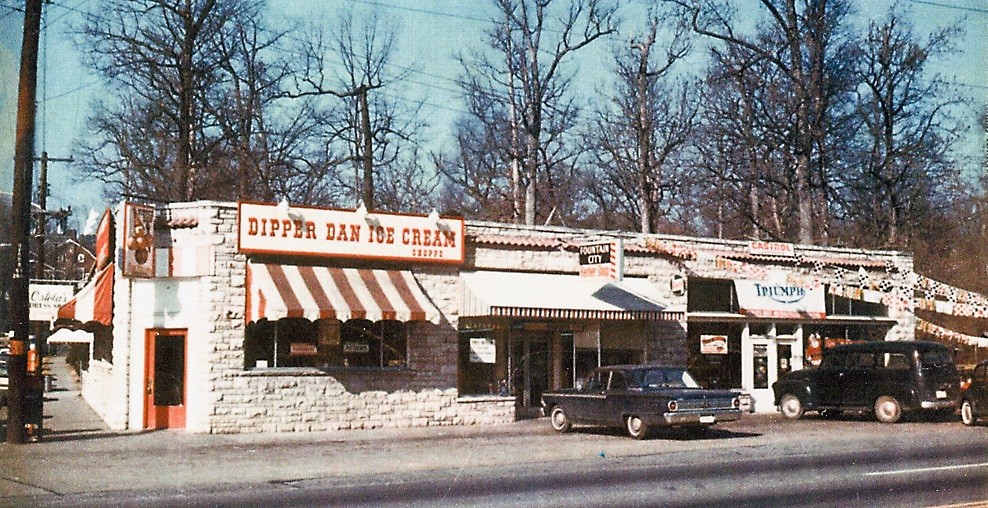The Fountain Head Railway’s final destination in Fountain City, “The Station,” has housed many businesses and has been the scene of many events since the demise of the railway in 1905.
Last month’s article described the interesting meandering route the “Dummy Line” took as it traversed the 5.25-miles from Central Market (now Emory Park) to Fountain City and also the Nov. 13, 1941, fire that destroyed the Fountain City Bank and the other five businesses which occupied the site. Probably the fire is still the most destructive in Fountain City’s history. The 6000-square foot building was in ashes and unofficial estimates of the loss were in the range of $50,000 to 60,000, a very large sum at that time.
But, there was much more history made on that corner, much of it in Sherman Wallace’s Fountain City Barber Shop. During the day the shop was a gathering place for many city and county officeholders and, after school was out, Central High School athletes and other young people made it lively.
In the mid-1920s, one young person who often stopped in after his days at Central was Roy Acuff. He entertained by playing some of the old-time fiddle tunes that John I. Copeland had taught him just a block away at his garage and service station, the first to be established outside of downtown. Even after Roy had become famous in Nashville and been named “The King of Country Music,” he would return to visit his friend Sherman Wallace and engage his friend, the longtime shoeshine man Charlie Duncan, in rag-popping contests.
One of the more interesting people associated with the Station area in the 1940s was Dossie Miller Cooper (1882-1968). Early on, Dossie and her husband, William F. Cooper (1876-1930), owned a confectionary at the corner of Hotel and Broadway across the street from the Station.
They also owned and operated a popular carousel located on the connector between the park and the lake. When her husband passed away, Dossie remained in her second-floor apartment with its quaint balcony lined with numerous ferns hanging almost halfway to the street. Her perch enabled her to “supervise” activity in the heart of Fountain City.

Cooper’s Corner (Circa 1906). Dossie Miller Cooper (1882-1968) lived in her second story apartment at this corner for over 60 years and supervised city workers and Central High students from her balcony. (Courtesy of Charles Williams, the artist)
When Fountain City was annexed in 1962, Dossie Cooper called her friend Knoxville Mayor John Duncan Sr. and said, “John, you’ve taken my job away from me.”
“Never mind, Mrs. Cooper, I’ll give it back to you,” Mayor Duncan said. So, she resumed supervision of the street cleaning crew.
High school students of that time will remember she also supervised them. Who can forget her leaning over the balcony and speaking to the students lingering after school? “You boys go on home,” she would say “you know your parents would not want you hanging around the station where older boys are drinking cokes and smoking cigarettes.”
The Station Building also had its downside. Many Fountain Citians will remember the bombshell article. The Knoxville News Sentinel (Dec. 18, 1962) announced on its front page that after he was investigated by the Secret Service and arrested by the FBI, Andrew L. Sprinkle had been charged with counterfeiting money at his business, the Padd Letter Service, at 105 Hotel Ave. in the Station Building.
Sprinkle testified that he had met brothers J.C. and Carl E. Smith at the Whittle Springs Snack Bar and been persuaded to print the money for them. He said, “I ran off $100,000 in $100 bills and $100,000 in $50 bills.” He had the special paper on hand for use in printing doctoral theses for UT students, a major source of business for him.
When they came to arrest him, he explained that he was in the middle of printing a thesis. He told the agents, “If you will let me finish it first, I will tell you what I know about the counterfeiting ring.” They waited for 30 minutes, then arrested him. Sprinkle was convicted and served a two-year term in federal prison.
But, the story has an upside. He was converted there and, when released, volunteered to speak to various local church and civic groups on his fall, his conversion and his return to society as a better man.
In the 1960s, the Broadway side of the building was occupied by Dipper Dan’s Ice Cream Shoppe, the Fountain City Barber Shop and Motorcycle Specialists. Sherman Wallace’s son, Ray Wallace, now ran the barber shop, while Lloyd Graham and Calvin Clements ran Motorcycle Specialists.
George W. and Adele Province owned Dipper Dan’s Ice Cream. Many will remember the especially “rich” ice cream which must have far exceeded present day butter fat content, as it was exceedingly creamy and tasty. On the Hotel Ave. side, Mrs. O.R. Holton owned Ostola’s Dress Shop, which later would move to the front and specialize in graduation and wedding gowns.
Richard E. and J.C. Tumblin bought the property in 1975 and re-named it the Fountain Head Building. Prominent businesses such as Kenneth Bowman’s JK Press, Galyon’s Jewelers and Linda Gay Blanc’s Edward Jones Financial Advisors would occupy space in the building over a period of years. Also, Dr. Jim Tumblin’s behavioral optometry office occupied the suite at 5219 for the last 21 of his 46 years in practice. He was later joined by Dr. John D. Tumblin who practiced general optometry with a specialty in contact lenses.
The present owner, Jack Amyx, president of Fountain City Finance at 5219 Broadway, bought the building in 1991 and extensively remodeled it in 2000. Edward Jones continues to occupy 105 Hotel Ave. and Remax Preferred Property is at 5315 Broadway.
The Station Building and its place in Fountain City history seem imprinted in memory and filled with promise for its future well into another century.
Sources: Knox County Public Library’s Papers to Pixels, N.L. Hicks’s A History of Fountain City (2000), J.C. (Jim) Tumblin’s The Fountain Head Railway Company (2003), Images of America: Fountain City (2004) and Fountain City: People Who Made a Difference (2016).


